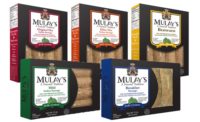In the growing meat snack category, there are easily identifiable categories. A meat stick is different from a meat bar, which is different from jerky. All three meat snacks have different looks, different textures and different tastes, and it is pretty easy to tell the difference between them. Then, there is biltong. It may look like jerky and may taste like jerky, but it is definitely not jerky. It’s a separate product, and the companies that offer it are hoping that it can capture a share of the American meat snack market.
Everywhere else in the world, biltong is known and enjoyed. The product originated in Africa, where the traditional methods of preserving meat by drying it merged with the European introduction of vinegar. Unlike jerky, the meat is not marinated prior to drying and contains much less sugar. Consumers looking to add protein to their diets without the sugar and nitrates found in jerky have an alternative in biltong. Stryve, a new meat snack company, originally sold jerky bites before discovering the health benefits of biltong. The company is now building the largest biltong plant in the country and making the product its focus.
“Consumers are not looking for another ‘me too’ option, a change of packaging or a change of flavor,” says Stryve co-founder and CEO Gabe Carimi. “They’re looking for a product that has beneficials to them, be it taste, flavor, micronutrients or a lack of preservatives. Everyone has their own specific [need], and biltong hits on a lot of those factors.”
Carimi’s introduction to biltong specifically and the meat processing world in general came after his first career was through. Carimi, a former offensive lineman, was the Number One draft pick of the Chicago Bears in the 2011 Amateur Draft and had a four-career with the Bears, Tampa Bay Buccaneers and Atlanta Falcons. When he left football, he became a fitness enthusiast and cut out snacking and sugar to improve his physical health.
“I used to go to the gas station and didn’t think twice about buying some jerky. I didn’t think about turning over the package and seeing that some jerky has 9 grams of sugar in a 1-ounce serving,” he explains, adding that more than half of the U.S. population is concerned about sugar intake.
The discovery of biltong and its nutritionals seemed too good to be true for Carimi, but the product was legitimate. He co-founded Stryve with Joe Oblas and Ted Casey , who both had experience in the supplemental nutrition world, to develop a line of healthy protein snacks. Biltong fit the bill perfectly.
Carimi says that biltong is traditionally sold in slabs and sliced at a deli counter. Stryve’s biltong, though it utilizes similar packaging methods as other meat snacks, is made with traditional methods. A top round muscle is completely trimmed of fat, washed in vinegar and then tumbled in vinegar and seasonings. It is dried for 14 to 21 days, losing about 50 percent of its weight and size in the process. Unlike Jerky, it is not smoked.
Strive sells biltong slices as well as biltong sticks — a modern adaptation of the traditional product. Flavors for the slices include Original, Zesty Garlic, Peri-Peri, Smoked and Teriyaki, while the sticks are available in Original, Mesquite BBQ, Hatch Green Chile and Spicy Peri-Peri.
The plan for Carimi and his partners was to own the entire process, which is why they are investing in the manufacturing end. Currently, the company owns plants in North Carolina and New Jersey, which are both allowed by the USDA to produce biltong.
“If you’re making jerky, you can go to any of the thousands of different co-packers that can smoke your product for you in 8 hours, but those same plants will not be able to produce USDA quality biltong,” Carimi says, referring to the differences in smoking jerky and air-drying biltong.
“We are building a state-of-the-art one in Oklahoma that will be open very soon, which will have the capacity of 10 times both our plants combined,” he adds.
Stryve biltong was released in August 2017. While all three partners are heavily involved in the sports nutrition and fitness world, they are determined to make biltong available to the mass audience.
“I know from buyers we have talked to at every channel, they are tasked to grow their category without growing their set. If you want to grow a category by adding another jerky, that’s a pretty hard task. How well can you market another jerky? We are a complete unique option to the U.S. consumer,” Carimi says.







Report Abusive Comment